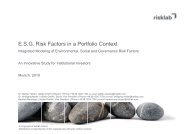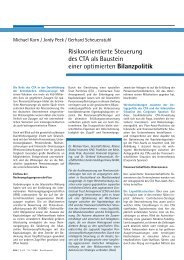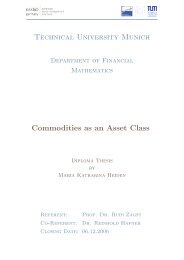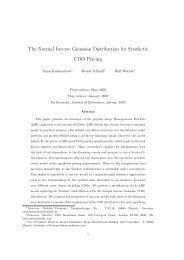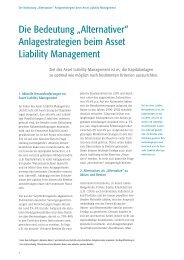Technische Universität München Credit as an Asset Class - risklab
Technische Universität München Credit as an Asset Class - risklab
Technische Universität München Credit as an Asset Class - risklab
You also want an ePaper? Increase the reach of your titles
YUMPU automatically turns print PDFs into web optimized ePapers that Google loves.
CHAPTER 2. CREDIT RISK TRANSFER<br />
• Systematic mispricing – Models for pricing credit derivatives are in <strong>an</strong> early de-<br />
velopment stage. There is no generally accepted pricing model. Partly, the used<br />
models are insufficiently able to map complex portfolio products, which c<strong>an</strong> lead to<br />
<strong>an</strong> underestimation of the real risk, <strong>an</strong>d thus to undesirably high risk <strong>an</strong>d to a wrong<br />
allocation of resources with a disequilibrating impact on fin<strong>an</strong>cial stability.<br />
• Agency risk – In terms of occurrence probability <strong>an</strong>d expected amount of loss, protec-<br />
tion sellers are able to better evaluate the tr<strong>an</strong>sferred credit risk th<strong>an</strong> the protection<br />
buyers. Therefore, there is a d<strong>an</strong>ger that the protection sellers only sell bad risks.<br />
This phenomenon is also known <strong>as</strong> adverse selection. A further agency problem may<br />
accrue from the fact that, after the credit risk tr<strong>an</strong>sfer, the protection buyer h<strong>as</strong><br />
little incentive to monitor the borrower in order to influence the occurrence proba-<br />
bility <strong>an</strong>d expected amount of loss in c<strong>as</strong>e of default. At the gr<strong>an</strong>ting of a credit, a<br />
b<strong>an</strong>k might be even less careful, knowing that she will hedge the credit risk. This<br />
phenomenon is known <strong>as</strong> moral hazard. 30<br />
• Regulatory arbitrage – B<strong>an</strong>ks effectively hedge against certain positions in their port-<br />
folio by tr<strong>an</strong>sferring the inherent credit risk to counterparties. This is particularly<br />
done with positions requiring more regulatory th<strong>an</strong> economic capital. Thus, regula-<br />
tory capital relief is accomplished, while credit risk exposure may then be <strong>as</strong>sumed<br />
by less regulated market particip<strong>an</strong>ts. This could result in <strong>an</strong> inefficient risk al-<br />
location <strong>as</strong> risk is systematically taken over by market particip<strong>an</strong>ts that have less<br />
knowledge <strong>an</strong>d experience in dealing with risks. Furthermore, they might have a<br />
smaller capital cushion to absorb unexpected losses <strong>as</strong> they are not regulated. Reg-<br />
ulatory arbitrage exploits inconsistencies in capital regulation <strong>an</strong>d is one of the main<br />
re<strong>as</strong>ons for continually improving capital requirements. 31 32<br />
• Market intr<strong>an</strong>sparency – As the credit derivatives market is <strong>an</strong> over-the-counter<br />
(OTC) market, there is <strong>an</strong> information deficiency. Information regarding the trading<br />
volume of credit derivatives often h<strong>as</strong> been b<strong>as</strong>ed on estimations <strong>an</strong>d polls among<br />
market particip<strong>an</strong>ts, but not on disclosure requirements. This insufficient tr<strong>an</strong>s-<br />
parency in the market <strong>an</strong>d the lack of insight into firm level exposures <strong>an</strong>d positions<br />
h<strong>as</strong> prevented <strong>an</strong> adequate <strong>as</strong>sessment of the risk allocation within a national econ-<br />
omy. Hence, the possibility to early identify potential systemic risks threatening the<br />
stability of the fin<strong>an</strong>cial system is limited. There are efforts to improve the tr<strong>an</strong>s-<br />
parency <strong>an</strong>d disclosure requirements with respect to fin<strong>an</strong>cial institutions. Not all<br />
market particip<strong>an</strong>ts, however, c<strong>an</strong> be included. 33<br />
To conclude, there are several risks in credit derivative markets that c<strong>an</strong> potentially<br />
threaten the stability of fin<strong>an</strong>cial markets. They are particularly import<strong>an</strong>t until the<br />
market is mature. At this stage, some risks have already been reduced successfully, for<br />
30<br />
This risk is more likely to be of theoretical nature. In practice, there are several mech<strong>an</strong>isms that<br />
prevent these risks such <strong>as</strong> reputation effects <strong>an</strong>d retention. (See [DBR04], p. 13, [Deu04], p. 42.)<br />
31<br />
Regulatory arbitrage is to be prevented through the implementation of B<strong>as</strong>el II <strong>as</strong> regulatory capital<br />
is calculated by taking into account the borrower’s <strong>an</strong>d the counterparty’s credit quality.<br />
32<br />
Deutsche Bundesb<strong>an</strong>k considers risk for the stability of fin<strong>an</strong>cial markets accruing from regulatory<br />
arbitrage not to be pivotal. (See [Deu04], p. 41.)<br />
33<br />
See [Deu04], p. 37-45, [DBR04], pp. 1-14, [BOW03], p. 211, [Fit05], pp. 2-3.<br />
17



